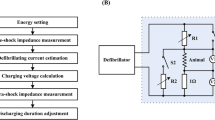Abstract
Introduction: Understanding the factors that affect defibrillation thresholds (DFTs) has important implications both for optimization of defibrillation efficacy and for the design of new lead systems. The objective of this prospective study was to evaluate the effect of shock polarity on defibrillation efficacy at the time of routine pulse generator replacement in patients with a hybrid patch-coil lead system.
Methods: Each patient underwent 4 assessments of DFT: monophasic or biphasic shock with standard or reversed polarity, with the order of testing with respect to polarity randomized. In standard polarity, the right atrial coil is the anode and the left ventricular patch is the cathode.
Results: The study population of 30 patients was 80% men with a mean age of 65 ± 9 years and a mean left ventricular ejection fraction of 33 ± 12%. There was a significant 21% decrease in the mean monophasic DFT with reversed polarity shocks (13.1 ± 5.9 J vs. 16.6 ± 6.5 J, p < 0.01). Reversal of shock polarity did not have a significant effect on the mean biphasic DFT (8.0 ± 4.8 J vs. 8.5 ± 4.3 J for reversed and standard polarity respectively, p = NS). However, when an elevated biphasic DFT (≥15 J) was present in either standard or reversed polarity, a significant decrease in DFT was observed when the opposite polarity was used (16.7 ± 2.5 J vs. 9.1 ± 2.7 J, n = 9, p < 0.0001).
Conclusion: Reversal of shock polarity markedly improves monophasic DFTs with the patch-coil lead configuration. The DFT should be determined with both shock polarities to optimize defibrillation efficacy for patients with high biphasic DFTs (≥15 J).
Similar content being viewed by others
References
Lang DJ, Heil JE, Hahn SJ, et al. Implantable cardioverter defibrillator lead technology: Improved performance and lower defibrillation thresholds. PACE 1995;18:548–559.
Gold MR, Shorofsky SR. Transvenous defibrillation lead systems. J Cardiovasc Electrophysiol 1996;7:570–580.
Bardy GH, Johnson G, Poole JE, et al. A simplified, singlelead unipolar transvenous cardioversion-defibrillation system. Circulation 1993;88:543–547.
Gold MR, Foster AH, Shorofsky SR. Effects of an active pectoral pulse generator shell on defibrillation efficacy with a transvenous lead system. Am J Cardiol 1996;78:540–543.
Tummala RV, Riggio DR, Peters RW, et al. Chronic rise in defibrillation threshold with a hybrid lead system. Am J Cardiol 1996;78:309–312.
Weiss DN, Shorofsky SR, Peters RW, et al. The effect of delivered energy on shock impedance. JICE 1998;2:273–277.
O'Neill PG, Boahene KA, Lawrie GM, et al. The automatic implantable cardioverter-defibrillator: Effect of patch polarity on defibrillation threshold. J Am Coll Cardiol 1991;17:707–711.
Bardy GH, Ivey TD, Allen MD, et al. Evaluation of electrode polarity on defibrillation efficacy. Am J Cardiol 1989;63:433–437.
Strickberger SA, Hummel JD, Horwood LE, et al. Effect of shock polarity on ventricular defibrillation threshold using a transvenous lead system. J Am Coll Cardiol 1994;24:1069–1072.
Shorofsky SR, Gold MR. Effects of waveform and polarity on defibrillation thresholds in humans using a transvenous lead system. Am J Cardiol 1996;78:313–316.
Strickberger SA, Man KC, Daoud E, et al. Effect of firstphase polarity of biphasic shocks on defibrillation threshold with a single transvenous lead system. J Am Coll Cardiol 1995;25:1605–1608.
Natale A, Sra J, Dhala A, et al. Effects of initial polarity on defibrillation threshold with biphasic pulses. PACE 1995;18:1889–1893.
Olsovsky MR, Shorofsky SR, Gold MR. Effect of shock polarity on biphasic defibrillation thresholds using an active pectoral lead system. J Cardiovasc Electrophysiol 1998;9:350–354.
Gold MR, Kavesh NG, Peters RW, et al. Biphasic waveforms prevent the late rise of defibrillation thresholds with a transvenous lead system. J Am Coll Cardiol 1997;30:233–236.
Cranefield PF, Hoffman BF, Siemens AA. Anodal excitation of cardiac muscle. Am J Physiol 1957;190:383–390.
Sweeney RJ, Gill RM, Reid PR. Characterization of refractory period extension by transcardiac shock. Circulation 1991;83:2057–2066.
Efimov IR, Gray RA, Roth BJ. Virtual electrodes and deexcitation: New insights into fibrillation induction and defibrillation. J Cardiovasc Electrophysiol 2000;11:339–353.
Efimov IR, Cheng YN, Van Wagoner DR, et al. Virtual electrode-induced phase singularity: A basic mechanism of defibrillation failure. Circ Res 1998;82:918–925.
Skouibine K, Trayanova N, Moore P. Success and failure of the defibrillation shock: Insights from a simulation study. J Cardiovasc Electrophysiol 2000;11:785–796.
Stroetmann B, Siemsen G, Straehler B. TiN: A suitable coating for defibrillator electrodes? PACE 1995;18:237–242.
Kirk MM, Shorofsky SR, Khalighi K, et al. Chronic rise in monophasic defibrillation thresholds with a transvenous lead system. Am J Cardiol 1997;79:502–505.
Singer I, Lang D. Defibrillation threshold: Clinical utility and therapeutic implications. PACE 1992;15:932–949.
Strickberger SA, Daoud EG, Davidson T, et al. Probability of successful defibrillation at multiples of the defibrillation energy requirement in patients with an implantable defibrillator. Circulation 1997;96:1217–1223.
Rattes MF, Jones DL, Sohla A, et al. Defibrillation with the sequential pulse technique: Reproducibility with repeated shocks. Am Heart J 1986;111:874–878.
Author information
Authors and Affiliations
Corresponding author
Rights and permissions
About this article
Cite this article
Rashba, E.J., Shorofsky, S.R., Peters, R.W. et al. Effect of Shock Polarity on Defibrillation Thresholds with a Hybrid Patch-Coil Lead System. J Interv Card Electrophysiol 9, 391–396 (2003). https://doi.org/10.1023/A:1027459814028
Issue Date:
DOI: https://doi.org/10.1023/A:1027459814028




